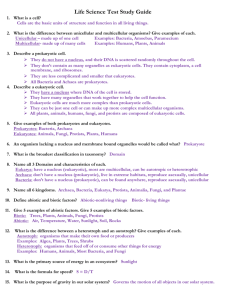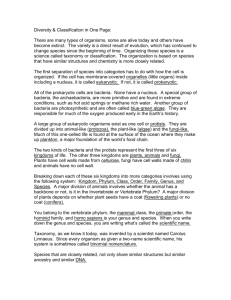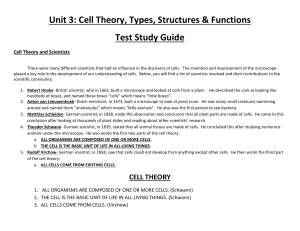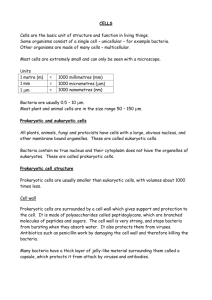2012 Training Handout
advertisement
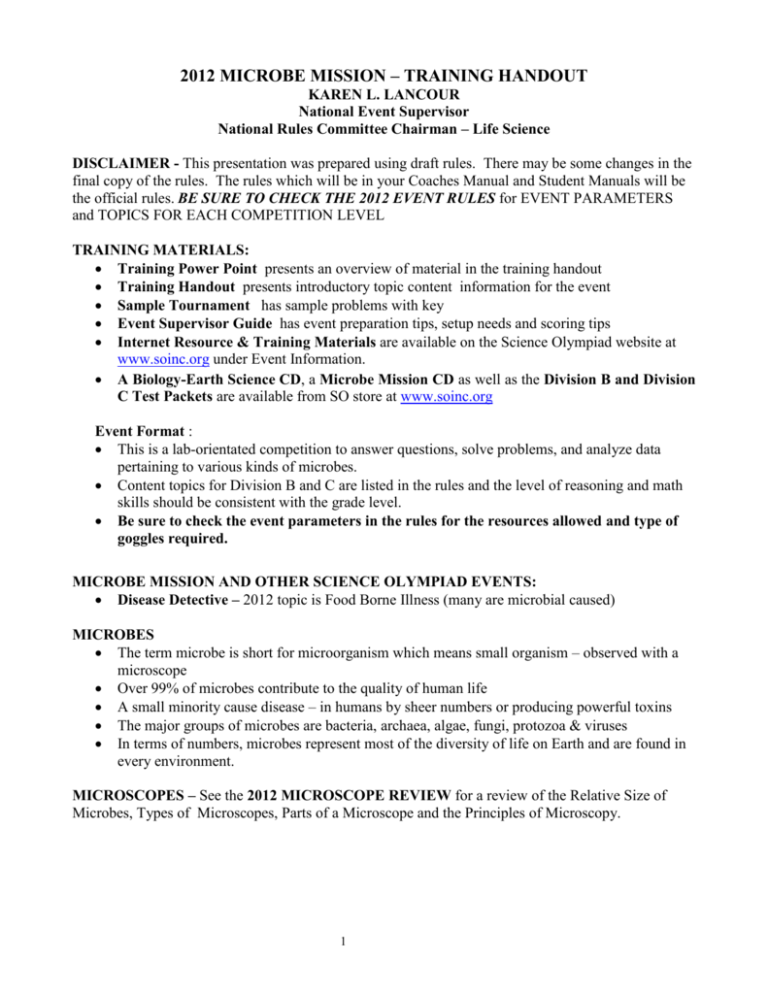
2012 MICROBE MISSION – TRAINING HANDOUT KAREN L. LANCOUR National Event Supervisor National Rules Committee Chairman – Life Science DISCLAIMER - This presentation was prepared using draft rules. There may be some changes in the final copy of the rules. The rules which will be in your Coaches Manual and Student Manuals will be the official rules. BE SURE TO CHECK THE 2012 EVENT RULES for EVENT PARAMETERS and TOPICS FOR EACH COMPETITION LEVEL TRAINING MATERIALS: Training Power Point presents an overview of material in the training handout Training Handout presents introductory topic content information for the event Sample Tournament has sample problems with key Event Supervisor Guide has event preparation tips, setup needs and scoring tips Internet Resource & Training Materials are available on the Science Olympiad website at www.soinc.org under Event Information. A Biology-Earth Science CD, a Microbe Mission CD as well as the Division B and Division C Test Packets are available from SO store at www.soinc.org Event Format : This is a lab-orientated competition to answer questions, solve problems, and analyze data pertaining to various kinds of microbes. Content topics for Division B and C are listed in the rules and the level of reasoning and math skills should be consistent with the grade level. Be sure to check the event parameters in the rules for the resources allowed and type of goggles required. MICROBE MISSION AND OTHER SCIENCE OLYMPIAD EVENTS: Disease Detective – 2012 topic is Food Borne Illness (many are microbial caused) MICROBES The term microbe is short for microorganism which means small organism – observed with a microscope Over 99% of microbes contribute to the quality of human life A small minority cause disease – in humans by sheer numbers or producing powerful toxins The major groups of microbes are bacteria, archaea, algae, fungi, protozoa & viruses In terms of numbers, microbes represent most of the diversity of life on Earth and are found in every environment. MICROSCOPES – See the 2012 MICROSCOPE REVIEW for a review of the Relative Size of Microbes, Types of Microscopes, Parts of a Microscope and the Principles of Microscopy. 1 CELLULAR LIFE - All cells have the following Has a membrane that separates the cell from the outside world Contains a nucleic acid as its genetic material (DNA or RNA) Use their genetic material to produce protein – structural or functional as enzymes and hormones Are composed of basic chemical as carbohydrates, proteins, fats, nucleic acids, vitamins, & minerals Regulate the flow of nutrients and wastes entering and leaving the cell Reproduce and are the result of reproduction Require a source of energy Interact with their environment CELLULAR VS. ACELLULAR Acellular – Viruses do not have cellular components, nor do they grow or metabolize organic materials. They generally consist of a piece of nucleic acid encased in protein which must use the cellular components of a living cell to reproduce. Prions (proteinaceous infectious particles) are infectious agents composed primarily of protein which induce the existing polypeptides in host cells to take on its form. Cellular – bacteria and Archaea are prokaryotic cells while algae, fungi, and protozoa have eukaryotic cells. PROKARYOTIC VS EUKARYOTIC CELLS Comparison Prokaryotic – single celled microorganism (archaea and bacteria) with nuclear material but no nuclear membrane or membrane bound organelles Eukaryotic – most cells – with organized nucleus and membrane bound organelles 2 Eukaryotic Animal Cell Eukaryotic Plant Cell Surface of Cell: Cell Wall – commonly found in plants cells – protection & support Plasma Membrane – control of substances coming in and out Cilia - sweep materials across the cell surface Flagellum - enables a cell to propel and move in different directions Cytoplasm – between plasma membrane and nucleus – many organelles Endoplasmic reticulum (ER) is the passageway for transport of materials within the cell Synthesis of lipids – modification of newly formed polypeptide chains Ribosomes are the site of protein synthesis Golgi apparatus- Final modification of proteins & lipids Packing of materials for secretion of the cell Mitochondria are the site of aerobic cell respiration-ATP production Lysosomes contain enzymes to digest ingested material or damaged tissue Chloroplasts – store chlorophyll – photosynthesis light reaction Vacuoles – storage – increase cell surface area Centrioles - organize the spindle fibers during cell division Cytoskeleton – cell shape, internal organization, cell movement & locomotion Nucleus: - control center of the cell Nuclear membrane – membrane around nucleus – controls movement in an out Nucleolus – assembly of subunits of ribosomes. DNA - encoding of heredity information RNA – transcription and translation of DNA coding into proteins 3 Organelles of Microbial Origin Eukaryotic cells are structurally and biochemically more complex than Eukaryotic cells There is strong evidence to suggest that Eukaryotic cells came from aggregates of Prokaryotic cells that became interdependent and eventually fused into a single larger cell. Nuclear material – is found in both Prokaryotic and Eukaryotic cells Mitochondria –have DNA similar to that of a Prokaryotic cell and can reproduce independent of the rest of the Eukaryotic cell. Chloroplasts – also have DNA similar to that of a Prokaryotic cell and can reproduce independent of the rest of the Eukaryotic cell. MICROBIAL GROWTH CURVE BACTERIA Composite of possible structures for bacterial cell Consist of only one cell – a prokaryotic cell Live in all environments – even above boiling point and below freezing point Are basically three shapes – spherical , rod, and spiral or helical Exist as individuals or cluster together to form pairs, chains, squares, or other groupings Some are photoautotrophic - make their own food as plants and give off oxygen – Cyanobacteria are also aerobic – use oxygen for respiration Purple and green bacteria are anaerobic Some are chemoautotrophic - synthesize their own food using energy from chemical reactions – important for recycling in nitrogen and sulfur cycles Some have flagella - rotates like a tiny outboard motor, others secrete a slime layer and move over surfaces like slugs, while others are immobile. Some form spores 4 BACTERIAL SHAPES bacillus is rod-shaped coccus is ball-shaped spirilium is spiral-shaped vibrio is comma-shaped cocco-bacillus is ovoid-shaped other combinations 5 DIV. C – BACTERIAL SHAPES, GRAM + AND GRAM - bacteria Gram positive Gram stain stain purple under bilayer wall of the have a thick polymer peptidoglycan. bacteria Gram negative stain red have a thin layer of this polymer and an additional lipopolysaccharide outer layer, LPS, often endotoxic - capable of initiating inflammation and cell-mediated immune responses e.g., Salmonella, Shigella, and Escherichia. ARCHAEA Are Prokaryotic Similar to bacteria in many characteristics Cell walls lack peptidoglycan + other differences Origin very old - during formation of the earth Extremely tolerant to heat, acid, and toxic gases Found in extreme habitats in anaerobic environments to produce methane, high salt concentrations or hot acid environments Involved in carbon & nitrogen cycles, assist in digestion, & can be used in sewage treatment ALGAL PROTISTS (ALGAE) diatoms Are Eukaryotic Found in fresh and salt water environments Can live on rocks, trees, and in soils with enough moisture Can carry on photosynthesis – produce large amount of oxygen for life on earth Diatoms, Volvox, Clamydomonas , Spirogyra Shells of diatoms – silica – mined to make abrasives Algal blooms can use up oxygen in water – harming other organisms as fish 6 ANIMAL-LIKE PROTISTS (PROTOZOA) Amoeba Protozoa means “little animal” – act like tiny animals - Eukaryotic Hunt other microbes for food Mainly feed on bacteria, also other protozoa and some algae Digest food in digestive organelles Ciliates, Amoebaes, Flagellates – organized by mode of transportation Amoeba, Paramecium, Euglena are examples Most are not harmful – a few are harmful Certain protozoa can cause dysentery and malaria FUNGI Yeast Cellular level, more like animals than plants – Eukaryotic Can’t synthesize their own food Single celled as yeast or multicellular clusters as molds & mushrooms Multicellular ones form filament like strands – hyphae Grow best in slightly acidic environment – can grow in low moisture Live in soil, on plants & animals, in fresh & salt water One teaspoon of topsoil has about 120,000 fungi Baker’s yeast for bread and brewing, some fungi are used for antibiotics, others are decomposers in the ecosystem Some cause disease in humans, animals and plants – ruin ¼ to ½ of fruits & vegetables per year VIRUSES Are acellular Consists of a piece of nucleic acid (DNA or RNA) encased in protein and in some cases a membrane-like envelope They come in many shapes Found anywhere there are cells to infest Exist to reproduce – must take over a suitable host cell Uses the cell machinery of the host cell to reproduce PRIONS proteinaceous infectious particles, associated with a number of diseases such as o Creutzfeld-Jacob disease (CJD) in humans o Gerstmann-Straussler-Scheinker syndrome (GSS) in humans o Alpers syndrome (in infants), o Fatal Familial Insomnia (FFI) in humans o Kuru in humans o Scrapie in sheep, o Bovine Spongiform Encephalopathy (BSE) or Mad Cow Disease in cattle o Chronic Wasting Disease (CWD) in wild ungulates such as Mule deer and elk These diseases are characterized by loss of motor control, dementia, paralysis, wasting and eventually death. 7 BENEFICIAL VS HARMFUL MICROBES Beneficial vs. Harmful Bacteria Most are beneficial (over 99%) contribute to the quality of human life They live in every environment on earth Microbes are important in ecological systems They are important to biogeochemical cycles Human digestion depends upon them They are important to the food industry and the productions of many products Microbes help with wastewater and oil spill cleanup A small minority of microbes cause disease FOOD PRODUCTION Milk into yogurt, buttermilk, sour cream, cheese Aid in production of chocolate, bread products, wine, beer, tea Pickling process to make pickles from cucumbers and sauerkraut from cabbage FOOD SPOILAGE AND DECOMPOSITION OF FOOD Microbes play a key role – bacteria and fungi – in food spoilage and decomposition Many types can live at low temperatures as mold on food in the refrigerator Food preservation techniques as salt and high acid affect microbes FERMENTATION PRODUCTS Carbon dioxide – bread making using baker’s yeast Alcohol – wine making and brewing using yeast Lactic Acid – lactic acid bacteria ferment milk into products as yogurt INDUSTRIAL USES Microbes (fungi and bacteria) are used to make antibiotics Algae are being used to make petroleum Yeast and bacteria are used in producing medicines MICROBIAL ECOLOGY Major producers in aquatic environments Decomposers – bacteria and fungi – in many ecosystems Key role in Biogeochemical cycles to recycle carbon, nitrogen, carbon, water Natural pest killers in gardens and on crops Breakdown oil from oil spills Serve as natural water treatment Can cause some ecological problems as red tide and algal blooms Involved in many symbiotic relations as lichens, human digestion, rumens of cows Key in maintaining ecological balance on Earth 8 WASTEWATER MICROBIOLOGY Microbes play a key role in drinking water and waste treatment facilities Are involved in natural waterways Involved in maintaining septic tanks Coliform bacteria as E. coli can contaminate water making it unsafe MICROBIAL DISEASES There are many agents of infectious diseases Microbes acting as agents are prions, viruses, bacteria, fungi, protozoa, parasitic worms Examples of common diseases for each to follow Be sure to check the SO National website for the final 2012 List of Diseases VIRAL DISEASES AIDS Chicken Pox & Shingles Common Cold Dengue Fever Ebola Hemorrhagic Fever Hepatitis (new) Influenza Measles Mumps Mononucleosis Polio Rabies Rubella (new) Small pox West Nile Fever Yellow Fever BACTERIAL DISEASES Anthrax Botulism Chlamydiasis (new) Cholera Dental Caries (tooth decay) Legionnaire's Disease Lyme Disease MRSA (new) FUNGAL DISEASES Athlete’s foot Dutch Elm Disease Ergotism Histoplasmosis Potato Blight Ringworm Thrush 9 Peptic Ulcer Disease Pertussis (whooping cough) Rocky Mountain Spotted Fever Strep throat Syphilis Tetanus Tuberculosis PROTOZOAN/ALGAL DISEASES Malaria Paralytic Shellfish Poisoning Estuary Associated Syndrome Giradiasis (new) Cryptosporidiosis (new) PRION DISEASE – Scrapie (new) Kuru (new) PARASITIC WORMS Hookworm Pinworm Schistosomiasis Tapeworm Trichinosis NATIONAL TOURNAMENT – ADDED DISEASES IMPORTANT GENERA ASSOCIATED WITH DISEASE Wolbachia Batrachochytrium 10




